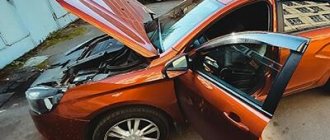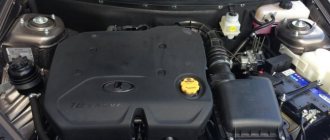The issue of gasoline quality is very acute for any car owner, both domestic cars and more expensive foreign cars. And quite a lot of people are sure that the more expensive the gasoline and the higher the octane number, the better it will be for the engine and injector of their car. But whether this is so and how justified the recommendations of the manufacturer AvtoVAZ are to fill the Lada Kalina strictly with AI-95 gasoline can only be seen from your own experience. This is what I wanted to talk about with all the blog readers below.
So, for the entire time I owned my Kalina, which is already more than two years and the odometer mileage is over 40,000 km, I refueled with both the most expensive 95th and the cheapest 80th fuel (there were hopeless situations). And I would like to share my experience of refueling various types of fuel.
Which gasoline is better: 92 or 95?
Some car brands support both 92 and 95 types of gasoline. In order to find out whether there is any significant difference between these types (and whether it is permissible to refuel a car for which the octane number recommended by the manufacturer is 95, 92 type), you first need to clarify the issue regarding the octane number. How does the functioning of the internal combustion engine depend on it?
There is an opinion that the type of gasoline clearly determines the quality of the fuel - higher means better, and the mixture burns more efficiently. However, this is not true. The first thing on which the combustion efficiency of the mixture depends is the engine itself - to be more precise, its adaptation to 92 or 95 type gasoline. After all, an increase in the octane number determines the duration of combustion of the mixture, but, what is even more significant, the power (due to the fact that combustion begins in the case of greater compression).
Due to the fact that the 95 is able to endure greater pressure before it begins to burn (unlike the 92), it is able to burn longer, which is an additional increase in the power of the machine. However, if the engine is not adapted to work with high-octane gasoline (or vice versa, with gasoline of a lower octane number than that recommended by the manufacturer), the engine efficiency, on the contrary, will decrease significantly - and this is clearly felt. This occurs due to premature detonation of gasoline with a low octane number, which ultimately does not burn completely.
In other words, when choosing fuel to fill the gas tank, the first thing to consider is what type of gasoline the car manufacturer recommended. Next, we will take a closer look at whether or not it is worth using different types of fuel for a number of cases.
The manufacturer recommended both 92 and 95
Some car models (it would be more correct to say “some designs of the engines of these cars”) allow you to refuel the car with both 92 and 95 types of gasoline. For example, a large list of mid-size sedans and crossovers (Hyundai Solaris, Toyota Corolla, Kia Rio, etc.) allows the use of both types of gasoline.
However, the question arises - which type is preferable? We can answer unequivocally – type 95. Longer combustion means increased efficiency. Moreover, in this case it is not always planned to accelerate faster or provide increased speed.
On the contrary, it is necessary to fill in 95-grade gasoline, adhering to the current driving style and dynamics solely for the purpose of saving fuel.
For this reason, often the increased price of 95 gasoline ends up being offset by its reduced consumption (of course, if the engine is adapted for this type of fuel). Diesel engines, however, will in any case be even more economical.
A huge number of drivers specifically fill their cars with type 92 instead of 95 - according to them, 95 gasoline is the same as 92, and the higher octane number is simply due to the use of a bunch of additives. But additives certainly won’t harm the engine, because they often affect the compression time before ignition begins. Although we note that a number of additives that may contain low-quality gas stations can really harm the car. Hence the conclusion - refuel the gas tank only at proven stations. Otherwise, you may experience a difference in driving dynamics as well as a change in engine sound.
But if the manufacturer recommends both types of gasoline, it is quite acceptable to fill the car with 92nd. Almost all new engines are able to adapt to the fuel mixture themselves, shaping the ignition timing in the event of premature detonation. Being installed on such cars, the knock sensor, when premature ignition is detected, shifts the advance angle to a smaller side, stabilizing the functioning of the engine.
92 instead of 95
You are probably aware that the fuel mixture in the engine ignites due to the supply of a spark by a spark plug at a specific point in time, determined by the operation of the 4-stroke cycle, due to which the mixture burns in the most optimal way. Gasoline with a low octane number ignites more quickly, creating a less stable combustion in an internal combustion engine with a high compression ratio. As a result, premature (or irregular) ignition of the fuel mixture in the combustion chamber can lead to a clearly audible knocking sound from under the hood - this is the so-called.
detonation, the cause of which is precisely the incomplete combustion of the gasoline mixture - moreover, it can burn out already in the exhaust system, namely in the catalytic converter. As a result, the metal parts of this device are sintered, and replacing the neutralizer is expensive. Although in reality the difference will almost always not be felt, only a slight increase in fuel consumption and a decrease in power. How is it that you filled the tank with 92 gasoline to save money? It’s very simple - 92 gasoline can burn less efficiently.
The reduction in power will be especially noticeable during dynamic driving (on the highway, for example).
Moreover, if you periodically pour 92 gasoline into the tank instead of 95, the result may be early wear of the engine and failure of the catalyst.
What oil is better to fill in the Lada Kalina 8 valve engine?
The duration of trouble-free operation of the engine on the Lada Kalina largely depends on the choice of oil and its timely replacement. Today, there is a problem in the fuel and lubricants market in the form of counterfeits that “kill” engine elements.
Another factor is the correct selection of oil for the Lada Kalina 8 valve engine, which almost every owner of this car can encounter.
The video below shows a test of automobile oils for the Lada Kalina.
What kind of fluid does the automaker fill in?
To find out, you need to check the inscription tag. As a rule, semi-synthetic or mineral lubricant Lukoil is used.
Lubricant consumption of up to a liter per 1000 km during normal operation of the unit is a common occurrence.
The amount largely depends on the viscosity, as well as how the model is used. High-speed driving and frequent acceleration require a larger volume of engine oil.
It is necessary to take into account: the new unit consumes more fluid, since its pistons, cylinders and rings are not ground in.
Markings
Let's look at oil manufacturers, as well as markings that can help you find out whether Lada Kalina supports a particular oil.
- Lukoil Lux. SAE class – QW-40, 10W-40, 5W30; group – SL/CF
- Luxe Hit/Best. SAE class – 10W-40; group – SL/CF
- Novile Super. SAE class – 5W-30, 20W-50, 15W-30; SJ/CF
- Rosneft Maximum/Premium. SAE class – 5W-40, 10W-40, 5W-40; SL/CF
- Tatneft Synthetic/Ultra. OW-40, 5W-30, 5W-40; SM/CF, SL/CF
- Esso Ultra. 10W-40, SJ/SL/CF
- Mobil 1.OW-40, 5W-50, 10W-40; SJ/SM/SL/CF
- Shell. 5W-40, 10W-40; SL/CF
- ZIC A. 5W-30, 10W-30; SL
As you can see, Lada Kalina owners have a wide selection of oils with different classes and standards. Based on these standards, a car enthusiast can safely fill in any oil from the specified list.
How to buy quality liquid?
When choosing a lubricant, it is necessary to avoid counterfeits. To purchase an original product, you should contact reliable retail outlets, monitor reviews, and order it online from the manufacturer. Beginning car owners and experienced car enthusiasts want the Lada Kalina to last longer. This is an inexpensive and simple model that does not require large maintenance costs, especially in terms of maintenance and consumables.
Good to know: Is it possible to add oil to an engine of another brand?
It is recommended to use exclusively the branded product specified by AvtoVAZ. Let's consider a method for choosing a quality lubricating product.
What fluid should I use for an eight-valve unit?
It is better to use synthetic and semi-synthetic fuels and lubricants for the engine. Mineral liquids should not be used. This condition is laid down by the local manufacturer and the association created by the car manufacturer.
With the production of injection engines, automakers decided: they should not fill in mineral motor oils, which create carbon deposits inside the combustion chamber. Mineral fluid is only suitable for carburetor engines.
What product should I put in Lada?
It is advisable to take into account the recommendations of the car manufacturer: the unit must be filled with liquids for gasoline units that correspond to SJ according to the international API classification. Viscosity is selected depending on climatic conditions.
Good to know: Designation of viscosity of motor oils | Engine oil viscosity index
How much engine oil is in Lada?
The lubrication system of the Lada Kalina unit contains 3.5 liters of engine oil, but after replacing it, 500 ml of old lubricating fluid remains, and 3 liters should be filled. After operating the unit for a short time, it is necessary to check the level and top up if necessary so that the level is between the marks.
When to change Lada engine oil?
In accordance with the recommendations of the automaker, the lubricant is replaced on a new or overhauled unit after 3000 km. The fluid is replaced at intervals of 15,000 km.
List of recommended brands
The Lada Kalina engine will work flawlessly if you use products approved by the manufacturer. Let's name the main recommended brands with which AvtoVAZ cooperates:
- Lukoil-Lux
- Luxe
- Novile Super
- Rosneft Maximum (Rosneft Maximum)
- Rosneft Premium (Rosneft Premium)
- TatNeft Synthetic
- TatNeft Ultra
- Esso Ultra
- Mobile 1
- Shell
- ZIC A
It is also noted that it is not recommended to use various additives, since modern oils already contain them.
Engine oil for Lada Kalina
Kalina is a small class variant produced by the automaker since 2004. The first generation had a station wagon and a sedan body, had 1.6 liter petrol units with a five-speed gearbox. The oil required for filling is indicated in the operating documents for the model.
TOTAL specialists offer synthetic fluid QUARTZ 9000, viscosity 5W40, which guarantees high-quality protection of the power unit from wear in arbitrary operating modes, thanks to the addition of special additives. It prevents the formation of various harmful deposits. Oxidative stability makes it possible to use this lubricant for a long period of time. Compliance with ACEA and API standards allows it to be used in power units of any modifications and generations of Lada Kalina.
Second generation
Since 2013, the Lada Kalina car line has been updated and new cars have entered the market. Among them was not the usual sedan, with which the series began production, but the production of 5-door hatchbacks and station wagons continued. Fuel consumption on the new Lada Kalina has been reduced, but the manufacturer's requests do not always correspond to customer reviews.
The second Kalina came with two types of engines, each with a volume of 1.6 liters, but their power differed. There was also a choice of transmission options; as before, it was possible to purchase a car with a manual 5-speed gearbox or with a 4-speed automatic. A new feature was the entry into the arena of a 5-speed robotic transmission.
The power units installed on the Lada Kalina 2 had the following fuel consumption:
- VAZ-21126 - 98-horsepower engine, 1.6 liter capacity. with four cylinders and 16 valves, it was equipped with a distributed fuel injection system. Gasoline consumption figures in the city are 9.9 liters, on the highway 6.5 liters.
- VAZ-21127 - had 106 hp at its disposal. And fuel consumption on a free road was 5.8 liters, in urban driving it was 8.4 liters. Gasoline was also supplied by distributed injection.
Owners about consumption on Kalina 2
- Peter, Tyumen. I bought a Lada Kalina Cross in 2015. This is one of the few representatives of the domestic automobile industry with horsepower exceeding one hundred. And indeed the car turned out to be lively; my hatchback can compete with some foreign cars when driving on open sections of the road. The other side of the coin is gasoline consumption in the city; I did not observe the promised 8.4 liters both during the run-in and after it. This engine consumes at least 10 liters per 100 km of road with traffic jams.
- Lev, Voronezh. My wife does not know how to use a manual transmission, so I had to buy a car with an automatic transmission system. The choice fell on the second generation Lada Kalina 2014. Naturally, I understood that, as with any automatic, fuel consumption would be higher than with a manual, and that’s what happened. My figures in the city, judging by the on-board computer data, are usually within the range of 11-12.5 liters per 100 km of traffic. This sad moment worsened three years after the purchase, the injector with nozzles became clogged, for some reason this happens more often on the 8-valve Kalina than on other engines.
- Taras. Moscow. I never regretted buying Kalina Cross for my baby; she often helped me out in situations when more expensive foreign cars failed. And when breakdowns happened, and this happens, the repairs did not cost me much at all. Of course, it cannot be considered a plus that the Lada Kalina has fuel consumption per 100 km, with a power of 106 hp. higher than foreign cars of the same class. In my case, in the city, I fill at the rate of 12 liters, but on the highway the situation changes dramatically and costs drop to 7.5 liters.
- Ilya, Odessa. For a car with such a price, many disadvantages are forgiven, but they exist. First of all, this is the fuel consumption of the Kalina; it can sometimes be compared with the performance of some SUVs. Regular failure of components and parts is also somewhat annoying, but the main thing for me is road noise. Compared to foreign cars, you feel as if you are driving without doors. Of course, there are also advantages: it is inexpensive to service and parts are always easily accessible.
- Andrey, Nakhabino. I don’t understand why people have so much hatred for the Lada Kalina, because you can find out everything about it before buying, and there are plenty of disadvantages, but there are also advantages. Mostly they complain about high gasoline consumption, but you can always install LPG and save money. The metal on the body is good and thick, its quality cannot be compared with Chinese tins. It’s just a pity that the quality of the factory paint is rather weak, and over the years bubbles appear in some places.
What kind of gasoline should I fill a viburnum with 8 valves?
How true is the statement that 92nd gasoline is better than 95th? Is it possible to mix different types of fuel? Why do VAZ and Renault-Nissan recommendations indicate different brands of gasoline for the same engine? And what should you put in the tank to save money?
It’s amazing how many questions appear in the mind of a Russian car enthusiast when he once again thinks about rising fuel prices. Yes, life is getting more expensive, and I don’t want to switch to public transport, so the thought of the possible use of low-octane gasoline comes to us more and more often.
So, what kind of gasoline should I fill in: 92 or 95?
Octane number
To figure out which gasoline is better to put in your car: 92 or 95, you first need to understand what the octane number (OC) is and what it affects. Of course, seasoned drivers know this without any education, but it will be useful for beginners to read this.
Attention: octane number (another name is detonation resistance) is a parameter that determines the ability of the fuel to resist the process of self-ignition when compressed in the combustion chamber of the engine. This means that the higher the OC, the later the gasoline ignites and the more efficient its combustion.
In turn, any engine is designed for a certain compression ratio. For example, VAZ engines have a compression ratio of 9.0 or 9.9. The instructions for cars equipped with these engines indicate that the recommended grade of gasoline is 92nd grade. What does this mean? And the fact that in this power unit 92-grade gasoline will not be able to spontaneously ignite. It will ignite only from a spark when the car is completely ready for it.
If spontaneous combustion of gasoline occurs prematurely, this leads to overheating of the engine, accelerated wear and even some breakdowns. Therefore, manufacturers always indicate which brands of fuel are allowed to fill a particular car.
Is it possible to fill in 95 or 98 gasoline instead of 92?
What kind of gasoline should I put in a tank designed for grade 92? Experts believe that it is acceptable to refuel with anything from 92 and above.
Everything is logical: if we fill the tank with fuel with a higher octane number, we reduce the likelihood of detonation in the cylinder, and this is an undeniable plus for the engine. This reduces the risk of breakdown.
It is quite expected that on 95 or 98 gasoline the car will run smoother and be able to develop more power, because the fuel in the chamber will burn with greater efficiency. In this case, the car may normally begin to consume a little less fuel. However, you shouldn’t expect a significant difference in car behavior and gasoline costs. Moreover: if, for example, a car is designed for 92 gasoline with a compression ratio of up to 10.5, then the use of 95 grade may lead to some loss of power.
Many motorists are confident that using 95 and 98 gasoline instead of 92 will lead to burnout of the cylinders. Perhaps this was the case in older cars, since their engines did not know how to adjust to changes in octane number. Modern cars are equipped with special electronic units designed to adjust the engine operating mode in accordance with the quality of the fuel filled.
BUT: the electronic unit (ECU) has specific operating ranges, so it is better not to take risks and not “jump” over the brand. That is, if your car, according to its passport, runs on 92-octane gasoline, then you don’t need to fill it with 100% gasoline, 95 will be enough.
Is it possible to fill in 92nd gasoline instead of 95th?
What kind of gasoline should I put in my car if the instructions say 95, but I really want to save money? Alas, only the 95th. You don’t want to be denied warranty repairs if there’s a breakdown, do you?
As soon as you fill the car with fuel with a lower octane rating, it will begin to “be capricious”: make clicking sounds reminiscent of the knocking of valves. This indicates detonation processes occurring inside the engine. Another sign of detonation is when the engine continues to run after you have already turned off the ignition. You can't expect anything good in this case.
To avoid serious damage and expensive repairs, it is advisable to drain low-octane gasoline from the tank as soon as possible and fill the car with fuel that fully complies with the manufacturer’s recommendations. If a breakdown does occur, the service center will quickly understand what happened. In this case, you will have to carry out all repair work at your own expense.
If you have an ECU, the negative consequences are minimized, but then you will significantly lose power. Is there any point in such savings?!
Is it possible to mix 92 and 95 gasoline?
When choosing which gasoline is best to fill, some are forced to mix two brands at once. For example, add a canister of 92 to the rest of the 95th. What comes of this and is it possible to do this?
Some people believe that mixing two “different octane” grades will result in some kind of averaged type of gasoline. In practice this does not happen. The lighter 95 gasoline rises completely above 92. It turns out that each fraction is consumed separately and no practical benefit can be obtained from such an experiment.
You need to understand that if, when mixing, you use gasoline with a lower octane number than prescribed in the instructions, then you at least risk increased engine wear (see the previous section).
Why octane number isn't everything
In principle, refueling a car is an extremely simple matter: go to a gas station; paid for the displacement at the required column; I waited until the ordered amount of fuel flowed into the tank and went about my business.
But... we are in Russia, where the quality of fuel often leaves much to be desired. Even if you know exactly what kind of gasoline you need to put in your car, you are not immune from purchasing fuel of lower quality. For a long time it was even believed that 92nd gasoline was much better than 95th. There was an opinion that 95 was greatly diluted in our country, so it would be cheaper and more correct to refuel with 92. Now the quality of fuel in large cities more or less corresponds to the declared characteristics, although there is still a risk of running into an unscrupulous seller.
First generation
The first sedan car went on sale in 2004; the car was equipped with a 1.4 liter engine with 89 horsepower. Fuel consumption of Lada Kalina 1118 (factory designation) had the following values:
- City - 9.6 l. per 100 km.
- Route – 6.3 l. per 100 km.
- Mixed pace - 7.8 l. per 100 km.
It should be noted that in 2009 the production of the first generation of LADA Kalina sedans was suspended, but within a few months the cycle was established, and until 2011 this model was produced by the AvtoVAZ concern.
Hatchbacks went on sale a little later, towards the end of 2006, and then production of the Lada Kalina (1119) was launched. These cars, as well as sedans, began to be equipped with a more powerful engine, which had a 1.6 liter fuel compartment and was produced with a power of 81 hp and 98 hp. According to the requests of the factory developers, which corresponded to the reviews of the owners, the car with an 81-horsepower engine had the following fuel consumption indicators per hundred kilometers:
- City - 10.2 l.
- Route – 6.6 l.
- Mixed temp – 7.4 l.
As for the 98 horsepower engine, the consumption per hundred kilometers of road under different conditions is:
- City - 9.7 l.
- Route – 6.4 l.
- Mixed temp – 7.1 l.
Only in 2007, the automobile concern rolled out the Lada Kalina with a station wagon (1117), its fuel consumption parameters are approximately the same as those of cars in other bodies, except that when driving in the city it consumes 200-300 grams. more gasoline.
One of the branches produced in limited series was the LADA Kalina Sport (11196), this car was released in 2008. Her gasoline consumption figures per 100 km are:
- City - 9.4 l.
- Route – 6.7 l.
- Mixed pace - 8.9 l.
Like the entire first series, LADA Kalina Sport ceased production in mid-2013.
Real data, according to owner reviews
- Victor, Saratov. I've been driving this car for a long time, everything has happened, except serious accidents, and I've gotten to know the car well. There are weaknesses in the body; the front arches began to rot especially quickly. But the engine is reliable, provided of course you use high-quality gasoline, oil and coolant. Lada Kalina with a 1.4 liter 16-valve engine has average fuel consumption. I drive mostly around the city and, as before, I pour ten liters per hundred kilometers in heavy traffic.
- Sergey, St. Petersburg. I bought a Kalina hatchback for maneuverable driving around the city while working. In 2010, I made a choice in favor of the 1.6 liter 16 valve version, and I think it was right. The car is really nimble, and the fuel consumption on this Kalina is even lower than on its less powerful brothers in the shop. Of course, very often you have to get stuck in traffic jams, so the figure of 11 liters per 100 km does not seem significant.
- Stepan, Ufa. I bought a good station wagon from the domestic auto industry first-hand in 2013; at that time the car was in good condition, although the struts were already knocking. During operation, everything else began to crumble, including the engine. The workshop said that I often filled with low-quality fuel, this seems to be true, the gas station near my house does not belong to any of the well-known networks. Kalina's consumption per 100 km is approximately 11-12 liters in the city, but on the highway maybe a little less, I didn't measure it.
- Yaroslav, Kazan. I live on the outskirts of the city and my work is shift work, so I can avoid major traffic jams and get to my destination with minimal fuel loss. Therefore, my sedan’s fuel consumption per hundred kilometers is slightly less than 9 liters. Otherwise, I am also completely satisfied with the Lada Kalina; she feels confident both off-road and on high-speed sections of the highway.
- Alexander, Konstantinovka. Buying a 1.6 liter Lada Kalina. and 8 valves, was not the best investment. I was guided then by the advice of my comrades, they say, this motor is the most reliable. In fact, the breakdowns were not long in coming, although they were minor, but I think others fail just as often. But the gasoline consumption of a car with such an engine is the highest; it simply does not have enough power to gain speed confidently. So it turns out that even on the highway she eats at least 9 liters per hundred square meters.
Deciding what gasoline to fill the VAZ 2114 with
Many motorists, especially those buying a car for the first time, are faced with a completely logical question - which gasoline is better for the VAZ 2114?
It does not arise by chance, because very often the information received by the car enthusiast contradicts each other. So, the passport of this model clearly states 95 gasoline, but many drivers and even employees of car dealerships and auto repair shops strongly recommend driving 92 gasoline. What to do in this situation?
First, let's turn to the opinion of many experts - when traveling within the city (that is, when driving with frequent stops and at lower speeds), it is better to use 92 gasoline, and when driving on the highway - 95. This recommendation is caused by the peculiarities of engine operation in different modes. For the same reason, it is recommended to refuel 92 in the cold season, and 95 in the warm season.
Pouring gasoline into a VAZ 2114
By following such recommendations, you can be sure of optimal fuel consumption and smoother operation of the car. True, some may object - what to do if there is no desire to change fuel when leaving the city on the highway or vice versa? Shouldn't you pour different fuels into one tank?
Yes, pouring gasoline of different brands into the tank at the same time is highly not recommended. For this reason, many motorists still choose one type of fuel. But which one exactly is up to everyone to decide for themselves.
The fact is that significant differences in gasoline brands are a thing of the past - previously, gasoline was produced using special additives that could increase the octane number (the so-called leaded gasoline), and running cars on the “wrong” gasoline could cause them to wear out quickly. Currently, such fuel is prohibited and is not used, so you can refuel a car with both 92 and 95 gasoline.
The real quality of gasoline (sometimes significantly different from gas station to gas station) is much more important than the octane number indicated in its name.
Advice from motorists
Often, car owners try to listen to the advice of other drivers, including on the issue of how to refuel a VAZ 2114. True, the advice here is radically different - one half drives a 92 and praises it, the other is in favor of a 95, because that’s what’s written in the passport and this is right".
In such a situation, it is worth recalling the above phrase once again - a difference of 3 octane units is quite insignificant and is poorly perceived by both the car and its driver (in the latter case, most opinions like “better are subjective”). An objective assessment here could be fuel consumption or the degree of wear of some elements, but they are almost the same (of course, there is a difference, but it is very small).
It is for this reason that we can say with confidence that it does not matter what kind of gasoline is poured into the VAZ 2114 - 92nd or 95th, what is much more important is not its octane number, but its quality.
A few octane units is a practically insignificant difference, making 95 and 92 gasoline interchangeable, not only when refueling domestic cars, but also when refueling many foreign cars.
Good gasoline - from a good gas station
It is probably no secret that many gas stations supply motorists with low-quality gasoline - diluted, with a low octane number, or simply lost in quality due to improper storage and transportation (when gasoline is poured into containers that have not been cleaned after other petroleum products). Situations like this are not uncommon these days and are common throughout the country.
Sometimes, even at two neighboring gas stations, the quality of gasoline of the same brand can be radically different. This is what every motorist should pay attention to - having visited several gas stations in your place of residence, and having found the best one, you should use only its services (of course, only if the quality of gasoline at this gas station does not drop sharply).
To once again prove the importance of choosing the right gas station, and not the right brand of fuel, we can give examples of octane number measurements at different gas stations: in less than half of the gas stations studied, 95th gasoline turned out to be really 95th. With 92, the situation is a little better, but not much (in general, according to statistics, the more expensive gasoline is, the more often it is counterfeited/diluted).
That is why it is much more important to choose a reliable fuel supply company and use only its services than to believe the numbers written on any random gas pump.
Gasoline supplier company
AI-92
As you probably guessed, I didn’t notice any difference between the octane numbers at all. The same confident engine start, smooth operation at idle and at high speeds, no detonation and not even a hint that the car didn’t like anything. After driving another 10,000 km only on 92nd fuel, I decided to unscrew the spark plugs again and assess their condition, and as it turned out, they were ideal, the same light gray color without the slightest deposits, which indicated a completely serviceable engine and system nutrition. As for consumption, this indicator has not changed at all throughout the entire time, the dynamics and traction remained the same. I concluded that the engine makes absolutely no difference to these changes of 3 units of octane number.











